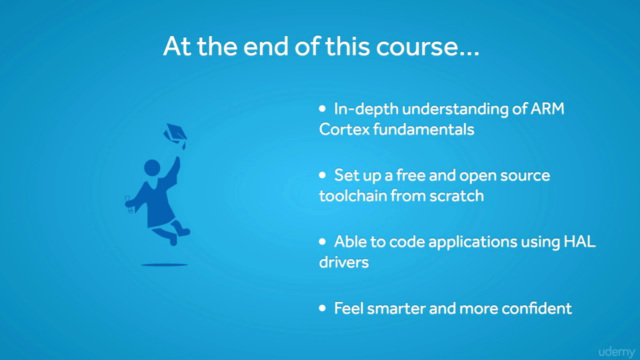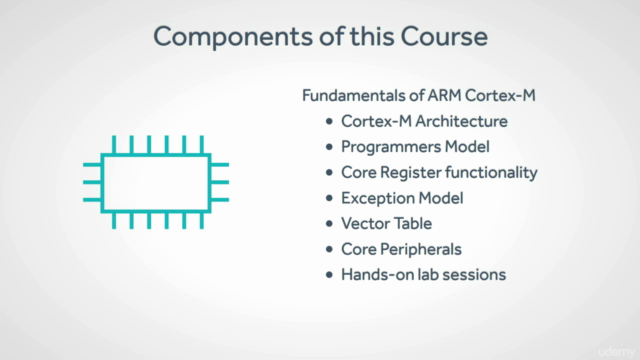Foundation of Embedded Systems with ARM Cortex and STM32
A 14 day proven course to a higher paying career in embedded systems, with deep understanding of ARM Cortex and STM32
4.45 (1110 reviews)

5 899
students
7.5 hours
content
Nov 2021
last update
$79.99
regular price
What you will learn
In-depth understanding of the ARM Cortex fundamentals
Set up a free and open source toolchain on your computer to program, flash and debug ARM based microcontrollers
Core register functionality like stack pointers, link registers, program counters, control registers, vector tables
Understand different types of exceptions on the ARM Cortex-M processor and what each of them mean
Understand different peripherals and how to program them
Hardware Abstraction Layer (HAL) Libraries and how to use them
Feel confident and comfortable programming applications on the Cortex-M platform
What is a programmers model and how it works for an ARM Cortex-M
Unprivileged and privileged software execution levels
Vector Table Offset Register (VTOR) and its uses
Big Endian Format vs Little Endian Format
OpenOCD (Open source debugger)
STCubeMX Application and how to generate HAL drivers
Course Gallery




Loading charts...
Comidoc Review
Our Verdict
This course excels at introducing students to ARM Cortex and STM32 microcontrollers. It lays a strong foundation in embedded systems while delving into essential concepts such as the Vector Table and UART communication. However, some areas could benefit from deeper exploration, real-world examples, and additional exercises for practice. The lecturer's presentation style is enjoyable and engaging throughout the course. While it might be helpful to include more advanced topics, this Foundations of Embedded Systems with ARM Cortex and STM32 course remains a valuable learning resource for beginners seeking an introduction to ARM-based microcontrollers.
What We Liked
- Covers fundamental concepts of ARM Cortex with STM32, providing a solid foundation in embedded systems
- Includes in-depth explanation of Vector Table and UART communication
- Provides setup instructions for Eclipse environment & STCube MX
- Lecturer's presentation style is unique and very pleasing
Potential Drawbacks
- Setup instructions can be lengthy, lacking video editing optimization
- Some sections could benefit from deeper exploration (peripherals, memory mapping, DMA)
- Background knowledge in computer architecture, memory, interrupts, and threads is assumed
- Occasionally lacks real-world examples and additional practice exercises
Related Topics
1343682
udemy ID
06/09/2017
course created date
08/02/2020
course indexed date
Bot
course submited by